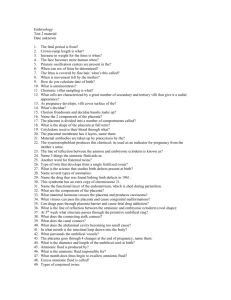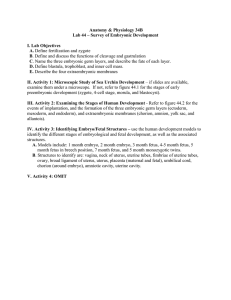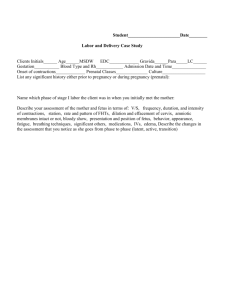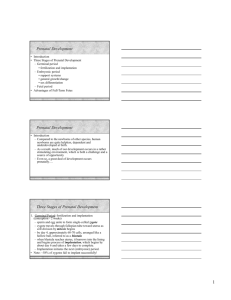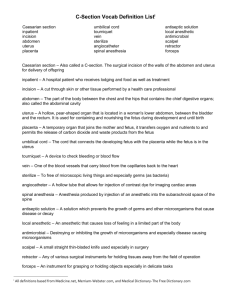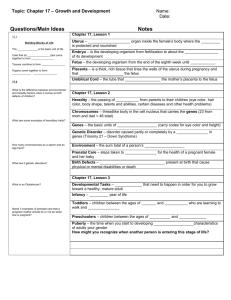Embryology lecture. HUMN110. Develoment in third month
advertisement
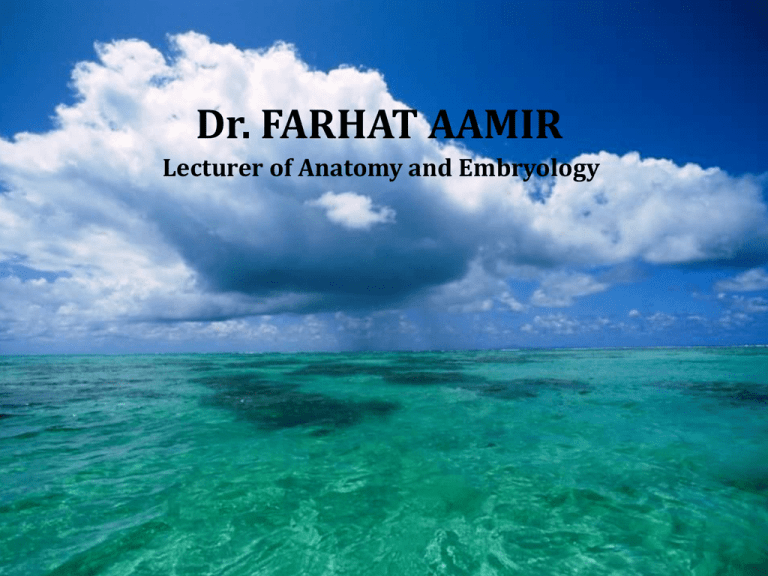
Dr. FARHAT AAMIR Lecturer of Anatomy and Embryology Objectives -Enlist the monthly changes in fetus from third month to birth. - Describe changes in trophoblast during formation of placenta. - Discuss formation of chorionic frondosum and decidua basilis. - Describe the structure of placenta. - Discuss circulation of placenta. - Identify clinical application’s i.e., placental barrier, hydrops fetalis, preeclampsia and low birth weight. Changes in fetus from 3rd month to birth - At the beginning of the 3rd month the head constitutes approximately ½ of the crown-heel length (CHL). - By the beginning of the 5th month the size of the head is about 1/3 of the CHL - At birth it is approximately 1/4 of the CHL. During the 3rd month: - The face becomes more human looking. - The eyes initially directed laterally then moved to the ventral aspect of the face. - The ears come to lie close to their position at the side of the head. - The limbs reach their relative length in comparison with the rest of the body. - Also by the 12th week the sex of the fetus can be determined by (ultrasound). An 11-week fetus. The umbilical cord still shows a swelling at its base, caused by herniated intestinal loops. Toes are developed, and the sex of the fetus can be seen. The skull of this fetus lacks the normal smooth contours. A 12-week fetus in utero. Note the extremely thin skin and underlying blood vessels. The face has all of the human characteristics, but the ears are still primitive. Movements begin at this time but are usually not felt by the mother. An 18-week-old fetus connected to the placenta by its umbilical cord. The skin of the fetus is thin because of lack of subcutaneous fat. Note the placenta with its cotyledons and the amnion. During the 4th and 5th months: - The fetus length increase rapidly and at the end of the first half of intrauterine life its crown rump length CRL is about 15 cm (about half the total length of the newborn). - The weight of the fetus increases little during this period and by the end of the 5th month is still <500 g. - The fetus is covered with fine hair called lanugo hair. - Eyebrows and head hair are also visible. - Movements of the fetus can be felt by the mother. During the 6th month: The skin of the fetus is reddish and has a wrinkled appearance. - A fetus born early in the 6th month has great difficult to survive. The respiratory system and the central nervous system have not differentiated sufficiently and coordination between the two systems is not well established. By 6.5 to 7th months: - The fetus has a CRL of about 25 cm and weighs about 1,100 g. If born at this time the infant has 90% chance of surviving. During the last 2 months: The fetus obtains rounded contours as the result of deposition of subcutaneous fat. By the end of intrauterine life the skin is covered by a whitish fatty substance (vernix caseosa). A 7-month-old fetus. This fetus would be able to survive. It has well-rounded contours as a result of deposition of subcutaneous fat. Note the twisting of the umbilical cord cord . At the end of the ninth month: - The skull has the largest circumference of all parts of the body. - The weight of the fetus is 3,000 - 3,400 g. - Its CRL is about 36 cm and its CHL is about 50 cm. - Sexual characteristics are pronounced and the testes should be in the scrotum Changes in the Trophoblast - The fetal part of the placenta is derived from the trophoblast and extraembryonic mesoderm. - At the 2nd month the trophoblast is characterized by a great number villi. 1. Primary villi: It is formed by trophoblast. 2. Secondary villi: It is formed by trophoblast and mesoderm. 3. Tertiary villi: It is formed by trophoblast, mesoderm and blood vessels. - The stem of the villi extend from the mesoderm of the chorionic plate to the cytotrophoblast cell. - The cytotrophoblast cell is covered by syncytiotrophoblast layer (syncytium). - During the following months small extensions grow out from the stem villi and form free villi into the lacunar or intervillous space. Chorion frondosum and decidua basalis Chorion frondosum: - In early pregnancy the villi cover the whole surface of the chorion. - As the pregnancy advances the villi on the embryonic pole continue to grow and form chorion frondosum. The villi away from the embryonic pole degenerate and form chorion laeve at the 3rd month. Decidua: - The decidua is endometrium of the uterus It includes 3parts: 1. Decidua basalis: It is the endometrium in contact with chorion frondosum. 2. Decidua capsularis: It is the part related to chorion laeve. 3. Decidua parietalis: It is the rest of the uterine wall. Structure of the placenta - At the beginning of the 4th month the placenta has two components: 1. Fetal portion: Formed by chorion frondosum 2. Maternal portion: Formed by the decidua basalis. - During the 4th and 5th month the decidua form a number of decidual septa which project in the intervillous space but don’t reach to the chorionic plate. - These septa have a core of maternal tissue and their surface is covered by layer of syncytial cells, so that the syncytial cells separates the maternal blood in the intervillous space from fetal blood in the villi. Full term placenta Shape: It is discoid shape Diameter: 15 – 20 cm Thickens: 3 cm Weight: 500 – 600 g Separation of the placenta after birth: Within 30 minutes. Maternal side: Formed of 15 – 20 cotyledons separated by decidual septa and covered by thin layer of decidua basalis. Fetal surface: It is covered by chorionic plate. - A number of large arteries and veins converge toward the umbilical cord. - The chorion is covered by the amnion. - Attachment of the umbilical cord is usually eccentric, sometimes it is marginal and rarely to the chorionic membranes. Circulation of the placenta - The cotyledons receive their blood through 100 spiral arteries that pierce the decidual plate and enter the intervillous space. - The blood return from the intervillous space to the decidua in the endometrial veins. - The fetal blood moves in the blood vessels along the chorionic villi. Placental membrane: It is the separation between the fetal and maternal blood. It is formed of: 1. Endothelial lining of the blood vessels. 2. Connective tissue in the villus core. 3. The cytotrophoblastic layer. 4. The syncytium. - syncytium. Clinical application 1. Hydrops fetalis: It is edema and effusion of the body cavities of the fetus. Causes: 1. Rh incompatibility: The mother Rh –ve while the baby Rh is +ve. is 2. ABO incompatibility: The mother blood group is O while the baby has different group. - Few drops from fetal blood passes to maternal blood leading to antibody formation against fetal blood 2. Preeclampsia: It is characterized by maternal hypertension, edema and proteinuria. - It leads to growth retardation or death of fetus 3. Low birth weight: The wight of the newborn is less than 2.5 kg (Normal 2.5 – 4 kg)
